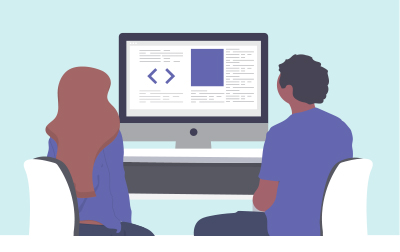Introduction to CSS Training (CSS101)
Course Length: 3 days
This course provides a comprehensive introduction to CSS (Cascading Style Sheets), a cornerstone technology used to style and layout web pages.

Register or Request Training
- Private class for your team
- Live expert instructor
- Online or on‑location
- Customizable agenda
- Proposal turnaround within 1–2 business days
- On Demand 24/7
- Readings, Video Presentations, Exercises
- Quizzes to knowledge check
- Life-Time Access
Course Overview
This course provides a comprehensive introduction to CSS (Cascading Style Sheets), a cornerstone technology used to style and layout web pages. It is designed for beginners and intermediate web developers who want to enhance their ability to create visually appealing and responsive websites.
The course starts with a crash course in CSS, covering the benefits of using CSS, the structure of CSS rules, and how to apply styles using selectors and combinators. You'll learn about the precedence of selectors, how browsers render pages, and the importance of CSS resets and normalizers. The module also covers the different ways to apply CSS, including external stylesheets, embedded stylesheets, and inline styles, with practical exercises to reinforce these concepts.
Next, the course dives into CSS Fonts, where you'll explore various font properties like font-family, @font-face, font-size, and more. You'll practice styling fonts and learn how to control the appearance of text with different font properties.
The Color and Opacity module introduces you to color values, opacity settings, and how to apply them to text and other elements, followed by a section on CSS Text, where you will learn to manipulate text alignment, decoration, spacing, and more. Exercises in these sections will help you solidify your understanding by applying these styles in practical scenarios.
In Borders, Margins, and Padding, you will get to grips with the CSS box model, understanding how padding, margins, and borders affect element layout. You'll also explore advanced properties like box-sizing and box-shadow, with exercises that focus on mastering these concepts.
The Backgrounds section teaches you how to control background colors, images, and other related properties like background-size and background-position. You will also learn to create classes and apply these properties through hands-on exercises.
Display and Visibility will cover how elements are displayed on the page, the difference between display and visibility properties, and how to control the visibility of elements within your web designs.
Pseudo-classes and Pseudo-elements are explored next, where you will learn to style elements based on their state or position in the document tree. You'll practice styling links, tables, articles, and other elements using these advanced selectors.
The course also covers Styling Tables with CSS, providing a review of HTML table elements and attributes, followed by practical lessons on applying CSS properties to tables for enhanced visual appeal.
Positioning elements on a page is a critical skill, and this course covers Normal Flow, the position property, z-index, and how to use float and clear for layout purposes. Exercises will help you practice positioning elements effectively.
Transforms and Transitions introduce you to dynamic styling techniques that allow you to animate elements and create smooth transitions. You'll practice using these properties to enhance the interactivity of your web pages.
The Layouts module covers advanced layout techniques including Flexbox, Grid, and multi-column layouts. You'll learn how to create responsive and flexible layouts that adapt to different screen sizes and devices.
In CSS Lists as Hierarchical Navigation, you'll learn to create navigation menus using CSS, including horizontal, vertical, drop-down, and fly-out menus. Exercises will guide you through building these navigation structures.
Finally, the Media Queries section teaches you how to create responsive designs that adapt to different devices and screen sizes. You'll explore breakpoints, Font Awesome integration, and targeting print with media queries.
By the end of this course, you'll have a strong foundation in CSS, equipped with the knowledge and skills to style and layout web pages effectively, create responsive designs, and enhance user experience through advanced CSS techniques.
Course Benefits
- Learn the benefits of CSS.
- Learn to avoid using deprecated HTML tags and attributes.
- Learn CSS syntax.
- Learn to use <div> and <span> tags appropriately.
- Learn all the common CSS properties and their values.
- Learn to use CSS resets and normalizers.
- Learn best practices for choosing units of measurement.
- Learn how to select CSS fonts and to download and use new fonts.
- Learn about color and opacity and to create backgrounds.
- Learn to work with borders, margin, and padding (the box model).
- Learn to style tables with CSS.
- Learn to use positioning.
- Learn to use transforms and transitions rotate, scale, and skew elements and create animations.
- Learn about flex, grid, and multi-column layouts.
- Learn to style lists and create drop-down and fly-out navigation menus.
- Learn to use media queries to style pages for different device sizes and media.
Delivery Methods
Delivered for your team at your site or online.
Learn at your own pace with 24/7 access.
Course Outline
- Crash Course in CSS
- Benefits of Cascading Style Sheets
- CSS Rules
- CSS Comments
- Selectors
- Type Selectors
- Class Selectors
- ID Selectors
- Attribute Selectors
- The Universal Selector
- Grouping
- Combinators
- Descendant Combinators
- Child Combinators
- General Sibling Combinators
- Adjacent Sibling Combinators
- Precedence of Selectors
- How Browsers Style Pages
- CSS Resets
- CSS Normalizers
- External Stylesheets, Embedded Stylesheets, and Inline Styles
- External Stylesheets
- Embedded Stylesheets
- Inline Styles
- Exercise: Creating an External Stylesheet
- Exercise: Creating an Embedded Stylesheet
- Exercise: Adding Inline Styles
- <div> and <span>
- Exercise: Divs and Spans
- Media Types
- Units of Measurement
- Absolute vs. Relative Units
- Pixels
- Ems and Rems
- Percentages
- Other Units
- Inheritance
- The inherit Value
- CSS Fonts
- font-family
- Specifying by Font Name
- Specifying Font by Category
- @font-face
- Getting Fonts
- font-size
- Relative font-size Terms
- Best Practices
- font-style
- font-variant
- font-weight
- line-height
- font
- Exercise: Styling Fonts
- font-family
- Color and Opacity
- About Color and Opacity
- Color and Opacity Values
- Color Keywords
- RGB Hexadecimal Notation
- RGB Functional Notation
- HSL Functional Notation
- color
- opacity
- Exercise: Adding Color and Opacity to Text
- CSS Text
- letter-spacing
- text-align
- text-decoration
- text-indent
- text-shadow
- text-transform
- white-space
- word-break
- word-spacing
- Exercise: Text Properties
- Borders, Margins, and Padding
- The CSS Basic Box Model
- Introduction to using Google Chrome DevTools with CSS
- Padding
- Margin
- Border
- border-width
- border-style
- border-color
- border-radius
- box-sizing
- box-shadow
- Exercise: Borders, Margin, and Padding
- Backgrounds
- background-color
- background-image
- background-repeat
- overflow
- background-attachment
- background-position
- Keywords
- Coordinates
- Creating a "hint" Class
- background-size
- background-origin
- background-clip
- Modifying the "hint" Class
- background
- Exercise: Backgrounds
- Display and Visibility
- display
- visibility
- Pseudo-classes and Pseudo-elements
- Pseudo-classes
- Styling Links with Pseudo-classes
- Styling Tables and Articles with Pseudo-classes
- :nth-child()
- Pseudo-elements
- content
- Using Pseudo-elements
- Styling Tables with CSS
- A Review of HTML table Elements and Attributes
- Spanning Columns and Rows
- CSS Properties and Styling Tables
- table-layout
- border-collapse
- Exercise: Styling a Table Exercise
- A Review of HTML table Elements and Attributes
- Positioning
- Normal Flow
- position
- Positioning with top, bottom, left, and right
- z-index
- float and clear
- float
- clear
- float, clear, and ::after
- Exercise: Positioning
- Transforms and Transitions
- transition
- transition-property
- transition-duration
- transition-timing-function
- transition-delay
- transition
- transform
- Rotation
- Scale
- Skew
- Translate
- Exercise: Transforms and Transitions
- transition
- Layouts
- Introduction to Flexible Box Layout Module
- Some Flexbox Properties
- Introduction to Grid Layout
- Some Grid Properties
- Multi-column Layout
- Exercise: Layouts
- Introduction to Flexible Box Layout Module
- CSS Lists as Hierarchical Navigation
- Exercise: Basic Vertical Navigation Bars
- Dynamic Drop-down and Fly-out Navigation Bars
- Exercise: Basic Drop-down Menu
- Exercise: Basic Fly-out Menu
- Exercise: CSS List Menus
- Media Queries
- What Are Media Queries?
- Breakpoints
- Media Types
- Syntax
- Font Awesome
- Finding and Using Icons
- Exercise: Breakpoints
- Exercise: Targeting Print
- What Are Media Queries?
Class Materials
Each student receives a comprehensive set of materials, including course notes and all class examples.
Class Prerequisites
Experience in the following is required for this CSS class:
- HTML
Prerequisite Courses
Courses that can help you meet these prerequisites:
Follow-on Courses
Have questions about this course?
We can help with curriculum details, delivery options, pricing, or anything else. Reach out and we’ll point you in the right direction.
